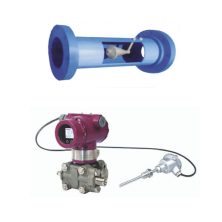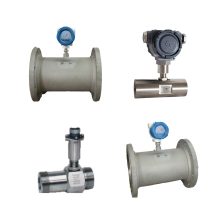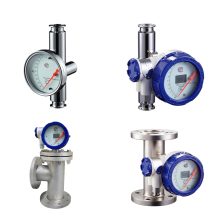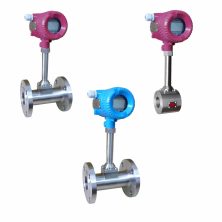As flow control is an essential requirement in many industrial processes, the global market for all flow meters has reached about 9 billion USD as of 2021 with a growth rate of 6-7% yearly. Liquid flowmeters represent over 80% of the total flow markets. Liquid flow meters are the both the most-used flowmeters in industry and the most technologically diverse, offering a myriad of choices based on an end user’s application requirements.
Plant efficiency and product outputs necessitate accurate measurement of liquid flow rates. Therefore, flow control is a critical need in many industrial settings. The ability to conduct accurate flow measurements is so important that it can make the difference between making a profit or taking a loss. Virtually all industries use liquids in their process and inaccurate liquid flow measurements or failure to take measurements can cause serious (or even disastrous) results. Smart Measurement has a wide range of liquid flow meters to fit your needs, which can be viewed below.
Featured Products

Ultrasonic Flow Meters
ALSONIC Series
Ultrasonic flow meters are flow meters offering a number of advantages over other traditional liquid flow measuring technologies. The most distinct of these advantages is the non-invasive nature of the ultrasonic measuring technique: fluid flow can be measured by clamping a pair of transducers onto the outside of the pipe without contacting the measured fluid. Today, ultrasonic and electromagnetic fluid flow meter technologies represent over 60% of all liquid flow measurement techniques used in industry.
Fluid velocity is measured by sending an ultrasonic pulse from an upstream transducer to a downstream transducer and back again. The measured difference in the amount of time that each pulse takes to traverse the pipe is directly proportional to the mean fluid velocity. Ultrasonic flowmeters use this measured velocity to calculate the liquid flow rate based on user-entered information about the process application. For a more detailed discussion of our ultrasonic flowmeter’s principles of operation, please visit our article about ultrasonic technology
SmartMeasurement offers the most comprehensive selection of ultrasonic liquid flow measurements with our ALSONIC series of products.

Magnetic Flow Meter
Mag Flow Meters
Magnetic Flow Meters, also known as mag meters, are liquid flow sensors having two non-moving parts that contact the measured fluid media – a liner that protects the flow body from the fluid and a pair of electrodes that detect the velocity of the flowing fluid. Compared to traditional mechanical flow measurement techniques such as turbine and positive displacement which rely on rotating mechanical gears and bearings, the mag meter’s simple construction provides for longer life, less maintenance, lower pressure drops, and overall lower cost of ownership. This design allows the mag meter to be used with virtually any conductive liquid regardless of density, viscosity, chemical composition, or fluid condition/particulate count. SmartMeasurement offers a wide variety of magnetic or mag flow metering choices in our ALMAG series.

Coriolis Flow Meters
ALCM Series
Coriolis flow meters are the only type of liquid flow meter that is capable of direct mass flow measurement. This makes the Coriolis meter an ideal choice for a number of applications that require the flow rate to be measured in mass units, including chemical mixing/batching, custody transfer, and emissions monitoring. Making use of volumetric flowmeters in these applications can prove to be challenging because converting the volumetric units to mass units requires the volumetric reading to multiplied by a media density value. For liquid fluid medias, the density value changes with temperature; for gas medias the density changes with both temperature and pressure. The changing density leads to inaccuracy when volumetric meters are applied in these situations. Mass flowmeters solve this problem by providing a direct mass flow measurement reading which is immune to changes in process temperature and pressure. SmartmeasurementTM’s ALCM Coriolis flowmeters offer a perfect solution for mass flow measurement of liquids.
SmartmeasurementTM has the most comprehensive selection flow metering technologies, offering our customers a smart solution for their individual application needs.

Positive Displacement (PD) Flow Meter
PD Flowmeters
Positive Displacement (PD) Flowmeters, are volumetric flow meters which employ one of the oldest-known techniques for measuring flow, are widely used in industry, and have one of the largest install bases of any liquid flow meter technology. Positive Displacement Flowmeters feature two precisely machined rotating members inside a measuring chamber of known volume which may be used to accurately determine the rates at which the volumes of liquid are passing through the chamber as a function of the rotors’ velocity. A more detailed discussion of the principle of operation can be found in our article about the positive displacement measuring principle. SmartmeasurementTM offers a variety of PD meters with our ALPD series.

Differential Pressure Flow Meters
DP Flow Meter
Differential Pressure Flow Meters are a flow monitoring technology which consists of a flow body containing some type of throttle restriction with known characteristics, such as a venturi, orifice, cone, or segmented wedge. This restriction creates a differential pressure between a pressure tap (P1) upstream of the restriction and a pressure tap downstream of the restriction (P2) which is proportional to the square of the volumetric flow rate. For a more detailed discussion of the principle of operation, you may want to read our article about the differential pressure measuring principle. SmartMeasurement offers the ACONE differential pressure flow element which provides the best accuracy and the lowest pressure drops of any other differential pressure (DP) flow technology on the market.

Turbine Flow Meter
ALTM Series
Turbine Flowmeters measure volumetric flow, where fluid passing through the tube is measured as a function of the mean velocity of the streaming fluid. Turbine flow meters may be configured to measure either gas or liquid flow rates. A low-mass turbine wheel carried axially in the tube is rotated by the fluid; the RPM of the turbine wheel is directly proportional to the mean fluid velocity within the tube. For a more detailed discussion of the principle of operation please go to our article about the turbine measuring principle. SmartMeasurement offers our ALTM series of turbine flow meters for liquid flow measurement with a variety of end fitting styles and sizes.

Variable Area Flow Meter
ALVAMT Series
Variable Area (VA) flowmeters measure the flow of liquids and are simple and versatile devices that operate at relatively constant pressure drops. Variable Area (VA) flowmeters make use of a float, piston, or vane placed inside a flow body, which changes position in response to changes in flow rate of the measured fluid media. The position of the float, piston, or vane provides a direct visual indication of flow rate. Either the force of gravity or a spring is used to return the float to its resting position when the flow lessens. For a more detailed discussion of the principle of operation, please read our article about variable area flow meters. SmartMeasurement offers our ALVAMT series of metal tube VA flow meters with dial type indicator for liquid flow measuring without the need for external power, with intelligent electronics requiring external power being available on an optional basis.

Vortex Flow Meters
ALVT Series
Vortex flow meters are the only flow measurement technology that can measure all three phases of a fluid; gas, liquid, and steam. Although it may be used as a liquid flow sensor, other flow metering technologies perform better in liquid applications. Therefore vortex flowmeters are primarily used in steam and gas applications. Vortex flow sensing technology relies on measuring the number of vortex pulses generated by a bluff body immersed in the flow stream. A machined bluff body is mounted inside the vortex meter’s flow body; as flow pass across this bluff body, vortices are generated in either side of the bluff body. The flow rate can be determined by frequency with which vortices are generated. For a more detailed discussion on vortex flow meters operation, please read our article about the vortex measuring principle. SmartMeasurement offers our ALVT series of vortex flow meters for measuring liquid volumetric flow rates.
The science behind flow measurement

As of 2021 the global market for all flow meters is about over 9 billion USD with a growth rate of 6-7%. Liquid flowmeters represent over 80% of the total flow markets. Not only liquid flow measurements are the most used flowmeters but it also the most diversified technological choices based on a user’s application requirements.
Plant efficiency and product outputs necessitates accurate measurement of liquid flowmeters. Therefore, measuring the flow of liquids is a critical need in many industrial plants. The ability to conduct accurate flow measurements is so important that it can make the difference between making a profit or taking a loss. Virtually all industries use liquids in their process and inaccurate liquid flow measurements or failure to take measurements can cause serious (or even disastrous) results.
Flow vs. Velocity

Liquid Flow Rate
With most liquid flow meters, the flow rate is determined inferentially by measuring the liquid’s velocity or the change in kinetic energy. Velocity depends on the pressure differential that is forcing the liquid through a pipe or conduit. Because the pipe’s cross-sectional area is known and remains constant, the average velocity is an indication of the flow rate. The basic relationship for determining the liquid’s flow rate in such cases is:
Q = V x A
where
Q = liquid flow through the pipe
V = average velocity of the flow
A = cross-sectional area of the pipe
Q above is volumetric flow rate and volumetric flow meters are the most traditional flow metering technologies. This means that the meter output or displayed value on the screen is in volumetric units of measure, such as Gallons Per Minute (GPM), Liters Per Minute (LPM), or one of many other flow units. Other factors that affect liquid flow rate include the liquid’s viscosity and density, and the friction of the liquid in contact with the pipe, as well whether a mass flow measurement is better for a given liquid flow application.
Density
Density is a measure of mass per unit of volume. The average density of an object equals its total mass divided by its total volume. An object made from a comparatively dense material (such as iron) will have less volume than an object of equal mass made from some less dense substance (such as water). The formula for density is d = M/V, where d is density, M is mass, and V is volume. Density is commonly expressed in units of grams per cubic centimeter. For example, the density of air is 1.2 kilograms per cubic meter. For measuring a flow: mass flow = volumetric flow (Q) times density(d).
The volume of liquid changes as changes in pressure and temperature occur, while its mass never changes. Older, early generation flow measurement technologies all made use of volumetric techniques for measuring liquid flow rates. However, in liquids, the effects of fluctuating temperature and pressure are not as critical as in gas flow measurement. Since volumetric flowmeters are cheaper with many measurement techniques available, they represent over 80% of all liquid flow measurement techniques.

Volumetric Liquid Flow
The volume of liquid changes with the changes in pressure and temperature, while its mass never changes. Volumetric measurement of liquid flow is the original technique to measure liquid flows by measuring the volume of liquid passing through a pipe or a channel. However, in liquids, the effects of fluctuating temperature and pressure are not as critical as in gas flow control. Since volumetric flowmeters are cheaper with many measurement techniques available, they represent over 80% of all liquid flow measurement techniques.
Viscosity
Viscosity is a measure of a fluid’s (in this case a liquid’s) resistance to flow. It describes the internal friction of a moving liquid. High viscosity liquids resist motion because its molecular makeup gives it a lot of internal friction. Some liquid flow meters are better at handling elevated viscosities than others. When measuring liquid flow, it is important to take into account the effects of viscosity on the flow measurement technology chosen.
Smart Measurement has the most comprehensive selection of flow metering technologies, offering our customers a smart solution for their individual application requirements.
